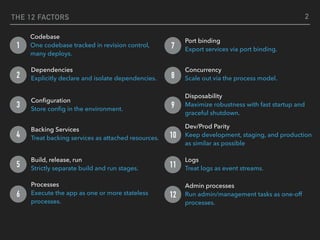12 factor apps
- 1. THE 12 FACTORS LIGHTNING TALKS ALICAN AKKUS@IYZICO 1
- 2. THE 12 FACTORS 1 2 3 4 5 6 8 10 7 11 9 CodebaseâĻ One codebase tracked in revision control, âĻ many deploys. DependenciesâĻ Explicitly declare and isolate dependencies. ConïŽgurationâĻ Store conïŽg in the environment. Backing ServicesâĻ Treat backing services as attached resources. Build, release, runâĻ Strictly separate build and run stages. ProcessesâĻ Execute the app as one or more stateless processes. 12 Port bindingâĻ Export services via port binding. DisposabilityâĻ Maximize robustness with fast startup and graceful shutdown. Dev/Prod ParityâĻ Keep development, staging, and production as similar as possible LogsâĻ Treat logs as event streams. ConcurrencyâĻ Scale out via the process model. Admin processesâĻ Run admin/management tasks as one-off processes. 2
- 3. THE 12 FACTORS 1 Codebase âĻ One codebase tracked in revision control, many deploys. âĻ This means you must not have various codebase for various versions. Branches and tags is okay, different repos are not. 3
- 4. THE 12 FACTORS 2 Dependencies âĻ A twelve-factor app never relies on implicit existence of system-wide packages. It declares all dependencies, completely and exactly, via a dependency declaration manifest. 4
- 5. THE 12 FACTORS 3 ConïŽguration âĻ Store conïŽg in the environment. The most important rule here is â never commit your environment-speciïŽc conïŽguration (most importantly: password) in the source code repo. Otherwise your production system may be vulnerable. 5
- 6. THE 12 FACTORS 4 Backing Services âĻ Treat backing services as attached resources. A backing service is one that requires a network connection to run. This is a very popular paradigm found in modern application development, especially prevalent with the rise in popularity of microservice architecture. The 12-Factor App methodology advises developers to treat these services agnostically, meaning changes or modiïŽcations should occur without having to make any code changes. 6
- 7. THE 12 FACTORS 5 Build, release, run âĻ Strictly separate build and run stages. The twelve-factor app uses strict separation between the build, release, and run stages. For example, it is impossible to make changes to the code at runtime, since there is no way to propagate those changes back to the build stage. 7
- 8. THE 12 FACTORS 6 Processes Execute the app as one or more stateless processes. Twelve- factor processes are stateless and share-nothing. Any data that needs to persist must be stored in a stateful backing service, typically a database. 8
- 9. THE 12 FACTORS 7 Port binding âĻ Export services via port binding. The twelve-factor app is completely self-contained and does not rely on runtime injection of a webserver into the execution environment to create a web-facing service. The web app exports HTTP as a service by binding to a port, and listening to requests coming in on that port. 9
- 10. THE 12 FACTORS 8 Concurrency âĻ Scale out via the process model. In the twelve-factor app, processes are a ïŽrst class citizen. Processes in the twelve- factor app take strong cues from the unix process model for running service daemons. Using this model, the developer can architect their app to handle diverse workloads by assigning each type of work to a process type. 10
- 11. THE 12 FACTORS 9 Disposability âĻ Maximize robustness with fast startup and graceful shutdown. The twelve-factor appâs processes are disposable, meaning they can be started or stopped at a momentâs notice. This facilitates fast elastic scaling, rapid deployment of code or conïŽg changes, and robustness of production deploys. 11
- 12. THE 12 FACTORS 10 Dev/Prod Parity âĻ Keep development, staging, and production as similar as possible. The twelve-factor app is designed for continuous deployment by keeping the gap between development and production small. 12
- 13. THE 12 FACTORS 11 Logs âĻ Treat logs as event streams. A twelve-factor app never concerns itself with routing or storage of its output stream. It should not attempt to write to or manage logïŽles. Instead, each running process writes its event stream, unbuffered, to stdout. During local development, the developer will view this stream in the foreground of their terminal to observe the appâs behavior. 13
- 14. THE 12 FACTORS 12 Admin processes âĻ Run admin/management tasks as one-off processes. The process formation is the array of processes that are used to do the appâs regular business (such as handling web requests) as it runs. Separately, developers will often wish to do one-off administrative or maintenance tasks for the app. 14















